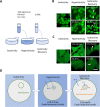Decompression Process of Glycerol Shock Treatment Can Overcome Endo-Lysosomal Barriers for Intracellular Delivery
- PMID: 33403275
- PMCID: PMC7774252
- DOI: 10.1021/acsomega.0c04771
Decompression Process of Glycerol Shock Treatment Can Overcome Endo-Lysosomal Barriers for Intracellular Delivery
Abstract
The glycerol shock treatment has been used to improve the calcium phosphate transfection efficacy for several decades because of its high effectiveness and low toxicity. However, the mechanism of glycerol shock treatment is still obscure. In this study, the endo-lysosomal leakage assay demonstrated that the decompression process of glycerol shock treatment could enhance endo-lysosomal membrane permeabilization, which resulted in facilitating endo-lysosomal escape for effective intracellular delivery. The enhanced decompression treatment derived from glycerol shock treatment could increase the change of osmotic pressure further, which showed higher efficacy for intracellular delivery. Herein, we speculated that the endo-lysosomal swelling originated from the decompression process of glycerol shock treatment could cause endo-lysosomal damage.
© 2020 American Chemical Society.
Conflict of interest statement
The authors declare no competing financial interest.
Figures






Similar articles
-
Metal-Organic Framework-Based Nanoplatform for Intracellular Environment-Responsive Endo/Lysosomal Escape and Enhanced Cancer Therapy.ACS Appl Mater Interfaces. 2018 Sep 26;10(38):31998-32005. doi: 10.1021/acsami.8b11972. Epub 2018 Sep 13. ACS Appl Mater Interfaces. 2018. PMID: 30178654
-
Rapid endo-lysosomal escape of poly(DL-lactide-co-glycolide) nanoparticles: implications for drug and gene delivery.FASEB J. 2002 Aug;16(10):1217-26. doi: 10.1096/fj.02-0088com. FASEB J. 2002. PMID: 12153989
-
Trehalose induces autophagy via lysosomal-mediated TFEB activation in models of motoneuron degeneration.Autophagy. 2019 Apr;15(4):631-651. doi: 10.1080/15548627.2018.1535292. Epub 2018 Nov 5. Autophagy. 2019. PMID: 30335591 Free PMC article.
-
Modulation of Calcium Entry by the Endo-lysosomal System.Adv Exp Med Biol. 2016;898:423-47. doi: 10.1007/978-3-319-26974-0_18. Adv Exp Med Biol. 2016. PMID: 27161239 Review.
-
Osmoregulation in Saccharomyces cerevisiae via mechanisms other than the high-osmolarity glycerol pathway.Microbiology (Reading). 2016 Sep;162(9):1511-1526. doi: 10.1099/mic.0.000360. Epub 2016 Aug 23. Microbiology (Reading). 2016. PMID: 27557593 Review.
References
LinkOut - more resources
Full Text Sources
Research Materials

